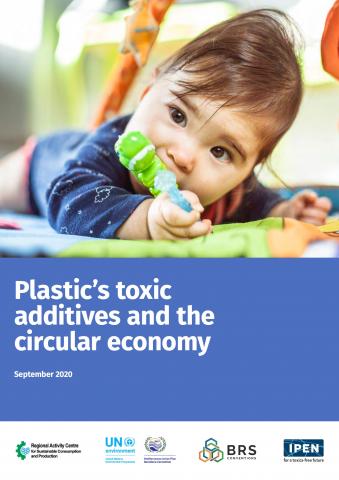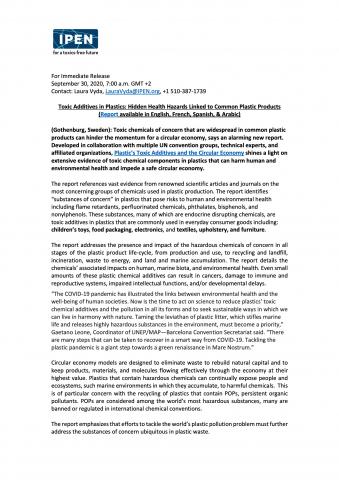Plastic's Toxic Additives
For Immediate Release
September 30, 2020, 7:00 GMT +2
Contact:
Laura Vyda, IPEN, lauravyda@ipen.org
Toxic Additives in Plastics: Hidden Health Hazards Linked to Common Plastic Products
(Gothenburg, Sweden) Toxic chemicals of concern that are widespread in common plastic products can hinder the momentum for a circular economy, says an alarming new report. Developed in collaboration with multiple UN convention groups, technical experts, and affiliated organizations, Plastic’s Toxic Additives and the Circular Economy shines a light on extensive evidence of toxic chemical components in plastics that can harm human and environmental health and impede a safe circular economy.
The report references vast evidence from renowned scientific articles and journals on the most concerning groups of chemicals used in plastic production. The report identifies “substances of concern” in plastics that pose risks to human and environmental health including flame retardants, perfluorinated chemicals, phthalates, bisphenols, and nonylphenols. These substances, many of which are endocrine disrupting chemicals, are toxic additives in plastics that are commonly used in everyday consumer goods including: children’s toys, food packaging, electronics, and textiles, upholstery, and furniture.
The report addresses the presence and impact of the hazardous chemicals of concern in all stages of the plastic product life-cycle, from production and use, to recycling and landfill, incineration, waste to energy, and land and marine accumulation. The report details the chemicals’ associated impacts on human, marine biota, and environmental health. Even small amounts of these plastic chemical additives can result in cancers, damage to immune and reproductive systems, impaired intellectual functions, and/or developmental delays.
-
Plastic’s Toxic Additives and the Circular Economy
Report on the issues related to toxic additives in plastics, safer alternatives, and pathways to reducing risks to consumers, respecting human and environmental health, and investing in sustainable solutions for the future.
-
Press Release
Translations of press release.
“The COVID-19 pandemic has illustrated the links between environmental health and the well-being of human societies. Now is the time to act on science to reduce plastics' toxic chemical additives and the pollution in all its forms and to seek sustainable ways in which we can live in harmony with nature. Taming the leviathan of plastic litter, which stifles marine life and releases highly hazardous substances in the environment, must become a priority," Gaetano Leone, Coordinator of UNEP/MAP—Barcelona Convention Secretariat said. “There are many steps that can be taken to recover in a smart way from COVID-19. Tackling the plastic pandemic is a giant step towards a green renaissance in Mare Nostrum.”
Circular economy models are designed to eliminate waste to rebuild natural capital and to keep products, materials, and molecules flowing effectively through the economy at their highest value. Plastics that contain hazardous chemicals can continually expose people and ecosystems, such marine environments in which they accumulate, to harmful chemicals. This is of particular concern with the recycling of plastics that contain POPs, persistent organic pollutants. POPs are considered among the world’s most hazardous substances, many are banned or regulated in international chemical conventions.
The report emphasizes that efforts to tackle the world’s plastic pollution problem must further address the substances of concern ubiquitous in plastic waste.
Rolph Payet, BRS Secretariat Executive Secretary, stated “There are a wide variety of chemical additives in plastics, some of them have been identified as Persistent Organic Pollutants (POPs) and are now listed under the Stockholm Convention – for example, brominated flame retardants and fluorinated water repellents. However, it is challenging for countries to manage POPs and other hazardous chemicals added to plastics throughout their life cycle including when plastic wastes are finally disposed of or recycled. We also need transparency on which plastics contains which additives, to enable their subsequent environmentally sound management. I urge industry and academia to intensify their efforts to find alternatives to such additives in plastics.”
"This report is notable because it identifies hazardous chemical additives in common, widely available products and illustrates how they pose a threat to health and the environment whether in products, in waste, in recycling, landfill, or incineration. In order to achieve a non-toxic circular economy, we must ensure a precautionary approach preventing hazardous chemicals in all stages of the lifecycle of plastics," said Dr. Sara Brosché, International Pollutants Elimination Network (IPEN).
The publication describes toxic exposures related to each state of the plastic life cycle from production through disposal. Contamination from hazardous substances resulting from plastic waste in landfills, incineration, pyrolysis, and recycling, as well as plastic pollution in the oceans and rivers, is detailed in the report. For example, emissions of highly toxic dioxins can result from the combustion of plastic waste, and technologies such as pyrolysis can result in the unintentional formation and release of fluorinated POPs (e.g. PFOA), other PFAS, including ozone depleting substances and greenhouse gases. “As the plastic industry aims to make new destinations for the world’s plastic waste in Africa our decision makers and the public must understand the toxic hazards intrinsic to many plastics and the related health and environmental implications of recycling, incineration, waste-to-energy, and landfill,” commented Griffins Ochieng, Executive Director of the Centre for Environment, Justice, and Development (CEJAD, Kenya) and leader in the global network IPEN.
Four key approaches are described in the report that can reduce the production and use of chemicals of concern, prevent regrettable substitutions, and realize a safe circular economy:
- Materials should be designed in accordance with goals of causing no harm to environmental and human health and achieving zero waste
- Investment must be made to develop new, safer materials and systems that avoid the production and use of plastics with hazardous chemical additives, and avoid the replacement of toxic additives with regrettable substitutions
- Industry collaboration will be key for industry to take responsibility for the hazardous materials they produce
- Transparent chemical composition labelling must be applied to all plastic materials
The report was produced by the Regional Activity Centre for Sustainable Consumption and Production (SCP/RAC), serving both the Stockholm Convention and the Barcelona Convention, with the active involvement of other regional centres of the Basel and Stockholm Conventions, the International Pollutants Elimination Network (IPEN), and experts from the Marine Litter Topic Group.
###


